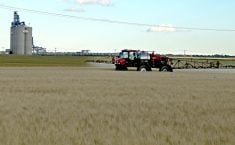Farmers who want to use crop residues as feed should consider chaff, which is suitable for a beef cow herd, said Murray Feist, a livestock agrologist with Saskatchewan Agriculture.
The department’s publication FarmFacts Chaff: Ammoniation, Nutrition and Feeding offers detailed information on this alternative feed. The guide was recently updated by Feist and Lyle Darwent, a provincial farm management agrologist in North Battleford. Feist re-examined the nutritional advantages of chaff while Darwent addressed the economics.
“To make the most economical use of chaff, you need to collect a high volume and, because it’s bulky, haul it short distances,” Darwent said.
Read Also

New coal mine proposal met with old concerns
A smaller version of the previously rejected Grassy Mountain coal mine project in Crowsnest Pass is back on the table, and the Livingstone Landowners Group continues to voice concerns about the environmental risks.
“For example, hauling an annual amount of 200 tons under two miles costs less than $20 per ton in total. Hauling an annual amount of 200 tons six miles results in a total cost of more than $30 per ton.”
FarmFacts provides examples that farmers can use to work out their own costs, including those of the additional equipment needed.
“In many areas, there will be lots of forage this year, but farmers who decide to collect chaff for feed should do it every year, regardless of the forage supply,” Darwent said.
“It’s more economical if they make it part of their annual operation.”
Grain producers benefit from chaff removal because it rids fields of weed seeds and chaff rows that can retard germination. The practice does not hurt soil conservation because the straw remains on the land.
Grain farmers might strike a deal with local cattle producers to take the chaff each year.
Ammoniation increases protein
The publication also addresses ammoniating chaff.
“Chaff that is not ammoniated can be similar to straw,” Feist said. “Typically, raw chaff has protein levels of three to four per cent and total digestible nutrients that range from 35 to 45 percent.”
However, ammoniated chaff has protein levels of eight to 12 percent and total digestible nutrient levels of 45 to 55 percent.
Ammoniation also improves roughage nutrient value and prevents weeds and seeds from germinating.
If chaff that is used as feed isn’t ammoniated, it must be treated like straw. Grain and protein supplements must be added to the diet.
















